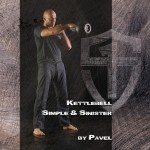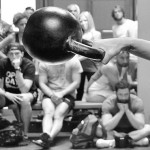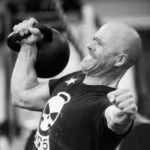We are proud to officially present Kettlebell Simple & Sinister: Revised and Updated Edition, or simply S&S 2.0.
Time is a man’s best friend if he makes good use of it and a man’s worst enemy if he lets it run him. Most people who live by the clock are miserable sorts of critters. But living by the sun, that is something different.
—Clifford Simak, Out of Their Minds
Glycolysis is the sugar burning that supplies faddish “high intensity interval training” and “metcons.” This highly inefficient process pollutes your body with lactic acid, ammonia, and free radicals and messes with your hormones if you tap into it too much or too often.
Anti-glycolytic training, in contrast, relies on the clean burning “rocket fuel” of creatine phosphate (CP) to power high intensity efforts and an equally clean aerobic system to replenish the CP. One way to ensure the anti-glycolytic nature of your training is the “talk test.”
Before World War II, Oxford professor John Grayson taught mountaineers to “climb no faster than you can talk.” This rule of thumb would eventually come to be known as the talk test.
Failing the talk test—not being able to speak in short sentences—means lactic acid is accumulating faster than the body can dispose of it. You are relying more on burning sugar without oxygen: anaerobic glycolysis. It is counterproductive to both ends of the S&S goal spectrum of power and conditioning.
Passing the talk test before the next set serves both of these seemingly contradictory goals.
For power, enough CP has been replenished aerobically to enable your fast twitch fibers to contract explosively. A failed talk test indicates that the creatine phosphate tanks have not been adequately refilled and the next set will rely heavily on glycolysis. Beloved by “Tabata” junkies, glycolysis is 1.5–2 times weaker than the CP system. So much for power.
Listen to Master SFG Mark Reifkind:
I come from a gymnastics and powerlifting background, and I like my rest. I prefer to start my next set when my heart rate has come down a bit and I can put my all into the next set…I don’t want to rob the next set of intensity by starting out of breath. The talk test is solid.
Passing the talk test indicates that lactate is not accumulating out of control and the metabolic environment is optimal for stimulating endurance adaptations. Endurance specialists know that these conditions—just a little acid to keep the aerobic metabolism humming but not enough to overwhelm it—are the key to developing championship stamina. Contrary to the HIIT propaganda, running at a speed that allows talking—just below the lactic threshold—is the most crucial component of serious endurance athletes’ training.
Per Verkhoshansky, the above applies to repeated high-power efforts just as much as it does to lower intensity steady-state exercise.
What would happen if you rested more or less than allowed by the talk test?
If you rest more, you will slightly gain on the power side and lose some endurance benefits, not to mention time.
If you rest less—sucking wind and letting your muscles burn—you will give your conditioning and body composition a short-term boost because your system perceives intense glycolysis as an emergency. But it must be done very sparingly—and only after building an aerobic base with talk-test restrained training. Overdo glycolytic work and there will be hell to pay.
In summary, the sweet spot of just passing the talk test is optimal for meeting the wide range of S&S goals, but if in doubt, it is better to rest more than less.
For American readers, a proven passage to recite for the talk test is the Pledge of Allegiance:
I pledge allegiance to the flag of the United States of America, and to the Republic for which it stands, one nation under God, indivisible, with liberty and justice for all.
Rif continues:
My way of training the swing is looking at the volume and intensity and not worrying so much about the rest intervals. These will naturally diminish as work capacity and fitness improves.
As you get into a better aerobic condition, your rest periods will decrease organically over a long haul, while fluctuating from day to day. Without apps and gadgets, the low-tech, high-concept talk test listens to your body and adjusts the rest periods in response to stress, fatigue, and everything else going on in your life.
Obey the talk test and do not forcefully cut your rest periods!
I know, I said it before. And I will say it again; it is that critical.
You probably would like to know how you stack against other gireviks. How long are you “supposed to” rest before passing the talk test?
There is no cut and dry answer. On one hand, the better your aerobic conditioning, the faster your recovery. On the other, the greater power you generate with each rep, the more CP fuel you burn, necessitating more rest. It is not unusual for a very powerful athlete to take half an hour to complete 10×10 max power swings guided by the talk test.
Even the Sinister finishers do not offer any numbers to shoot for in your daily S&S practice. When they have completed their 100 swings in five minutes, their power was high—but not maximal, as their day-to-day talk test regulated training.
Let Master SFG Pavel Macek, who has met the Sinister swing golden standard—10×10 with 48kg within five minutes—at a bodyweight less than 150 pounds, put your mind at ease about longer rests:
During my regular S&S practice, I always give myself plenty of rest—more than I feel I need. A relatively long rest period allows me to do an absolutely explosive set of 10 hard style swings with a “one punch, one kill” mentality. I only time my rest periods during the test days, and I don’t ‘try’ to hit the standard (100 hard style swings in five minutes). I am 100% sure I can do it, so I just do it.
The results of this strategy? In addition to the desired conditioning effect, I experience more strength and power and less soreness. On my 40th birthday, exactly one year after I started S&S, I did 40 consecutive one-arm swings with the Beast. The session looked like this: 20 with my left, switch, 20 with my right, set down, celebration dance.
To sum up, there is no rest period to qualify you as a stud or studette. Do not look at the clock at all. Doing so could only provoke wrong decisions. Listen to your body and your breath—not your watch or phone.





Pavel,
The first part of the book calls for doing 2 hand swings every third session. The second part does not say to stop doing those post Timeless Simple. If one chooses to do only three sessions overall per week, chasing Sinister, then it’s only a single session with heavier bells single hand swings. The other are two hand or timed sessions with lighter bell.
There is a thin line between this minimum Sinister training with 3 sessions and Timeless Simple maintenance 2 times a week.
Would you still recommend doing the two hand swings weekly with only those 3 sessions in a week, or should one do it less often in order to provide more one hand heavy bell sessions?
Btw. I love updated S&S. The refining seems to be minor at first glance, but it makes so many differences in training.
Thanks!
I’ll add a second query. Do you think that hook grip without over gripping is possible with heavy bells?
Pavel,
what do you suggest if S&S (2x per week) as GPP-addition to a strength training regimen (3x per week) causes some irritation in the SI-Joint?
My form has not been checked by an SFG but by a very knowledegable coach in my gym who could not spot any flaws.
Do you think that my mobility is not up to par, or do you maybe know of a case where S&S (I beleive the one-arm Swing is my main problem) led to problems in the SI-joint?
Many thanks in advance for your answer!
Best regards from Germany,
Jens
After reading, it seems logical that this paradigm shift includes the ETK:Rite of Passage conditioning component. Results of RoP ‘as written’ are just so good that I’ve been hesitant to take that “one step to the left” (plus the whole thing about us getting shot if we do).
Do you have, or have you considered, a revision to the RoP conditioning protocol?
It’s easy enough to wait for talk test compliance before next sets, but there are a few other aspects of the plan where, for me, adjustments are not as obvious.
Do you have any hints for how to re-calibrate the 50% effort lite, 80% effort medium and 100% heavy days?
Is the reduction in volume on H and M days a necessary consequence of ‘don’t swing/ snatch more than you can talk’ or would you consider something like adding extra dice and converting rolls from minutes to sets?
… Or maybe there is an altogether different template which better embodies the new strategy when the goal is still a 10 minute snatch test and 1/2BW C&P?
Thank You!
Pavel
How does your approach compare to the MAF Method of Dr. Phil Maffeltone? He advises to monitor your heart rate so that your body stays in the aerobic zone. Typically, I can talk when in this aerobic zone. Today when I did 20 sets of swings, I made sure that my heart rate got below 115 before starting another set as my maximum heart rate would get to the mid 130s. (It did take some experimentation to figure out how low I needed to get my heart rate before starting again.) I did not pay attention to the time in between sets; I simply watched my heart rate. I appreciate knowing if there are significant differences.
Bauer, if you can still progress withing that time frame—great. If not, extend the time to stay with a given load.
Definitely ease in after a lay-off. Use Pavel Macek’s sample cycle on p. 91 and your judgment.
Thank you for your kind words!
Thank you!
Hello,
Pardon my ignorance, but it is not clear to what are the (main) updates from the previous edition of the book.
Thank you,
@Antonio, please see https://www.facebook.com/bestrongfirst/posts/2978594168827117
The sixth paragraph begins, “Pavel explains how he improved S&S in the new edition:” and continues with a bulleted list.
Steve Freides
Dir. Community Engagement
StrongFirst
Wow – ‘revised and updated’ often means a few tweaks in other books but this is a total reworking/rethinking of a classic, that is even better! Well worth purchasing, even if you have the original.
I commend the work and distillation of ideas in this Pavel. Thank you.
As a bodyweight fan myself, have you any plans to refresh Naked Warrior in a similar way? Or return to a bodyweight program in future work?
Thanks for all you do.
Thank you for your kind words, Carl! Please do me a favor and post a review on https://www.amazon.com/Kettlebell-Simple-Sinister-Revised-Updated-ebook/dp/B07ZQKWMKR/ref=zg_bs_11717429011_1?_encoding=UTF8&psc=1&refRID=Y1XV2KSFVFZTA1EEJY0D.
I am working on several books; too soon to be specific.
Done (I’m a U.K. customer) and being processed by Amazon.
Look forward to whatever’s next.
My 2 cents as a judoka and S&S devotee:
I never cared much about compressing rest times. I just waited till I felt good and did the next set HARD. The entire thing took generally about half an hour, and this is with the 32 for swings and the 40 for getups.
My two cents on the matter is that when it comes to judo, the S&S moves are WAY more extreme than anything you normally do in judo training (except in some kind of championship tournaments), so totally wiping myself out to hit some kind of arbitrary time limit in S&S is just overkill as far as judo practicality goes, at least for my own little world, haha! Pumping out swings with one hand at 1/3 my bodyweight is pretty extreme compared with unbalancing someone just once for a throw timed at the right moment.
In any case, I felt I was right not to compress rest times too much. I felt I was getting more out of it by waiting until I could breathe fine again.
I feel vindicated. 🙂
Great to hear, Kozushi!
I have not received my copy but I am sure I will shortly.
Pavel, I read a lot, especially everything you wrote. I am very interested in the whole A+A style training. I just ask myself how often do you have to do glycolytic sessions to be ready when it counts.
I work as a Police Officer and when I have to run after someone, get up stairs and fight this subject afterwards, I am full into my glycolytic energy system. I wonder if I won’t miss something without training this state from time to time. For me, the glycolytic state is very realistic and can happen pretty often. So that’s where I have to perform if it counts.
Thanks for your work and your answer.
Xene, please read the book and, if you still have this question, post again.
I will, should be arriving in the end of November. Will come back to you.
Xene,
I work as a LEO as well. I’ve had this debate multiple times with myself in regards to when to hit the glycolytic throttle.
I’ve been doing S.S on-and-off for about three years, currently using the 48kg for both exercises.
In my experience, i believe it’s still best to hit the glycolic at least twice a month; however, most days I keep it around 7-8 on the volume knob.
This has worked for me, but listen to Pavel and read the revised version and see for yourself.
good luck and stay safe.
-Guy
Pavel, congratulations on perfecting a masterpiece! “Proven – Powerful – Perfected” indeed.
I have four quick clarification questions on some fresh aspects from S&S 2.0:
1) Barbell + Simple maintenance = 3x/week Reload, PttP or Easy Strength + 2x/week S&S with Simple weights?
2) Working on Timed Simple still includes 2H swings about once per week, right?
3) Should one still add one step of S+ or G+ after Timeless Simple every 4 weeks or a bit slower (as there are less sessions per week and there are sessions with S- and G-)?
4) What happened to the “evil slow TGU” for off-days?
I enjoyed reading the revised edition and am looking forward to implementing it. Thanks again for all your works.
Thank you, Bauer!
1) S&S Timeless 2/week + ES 2-3/week
2) Refer to the book.
3) Please clarify the question.
4) Feel free to do it.
Thank you Pavel! As for question 3:
My question is if step cycles still last 4 weeks after achieving Timeless Simple, given that there will be only 2-3 sessions with the heavier weights (S+) per week and one session with S-, resulting in 8-12 working weight sessions per 4 weeks.
And allow me a second question on step cycle length: Is there a rule og thumb for dealing with weeks off? Should one just resume to cycle after a week of, say, Christmas holidays, or take a few extra sessions?
PS: Having read Easy Strength lately made me appreciate the simplicity of S&S even more. I admire the elegance of the exercise selection amd programming in light of all the research and myriad of programs out there!